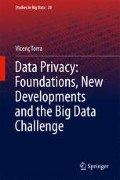Abstract
We have users’ privacy when users have an active role to protect their own privacy. In this chapter we review user privacy in communications and in information retrieval.
Access this chapter
Tax calculation will be finalised at checkout
Purchases are for personal use only
References
Edman, M., Yener, B.: On anonymity in an electronic society: a survey of anonymous communication systems. ACM Comput. Surv. 42, 1–5 (2009)
Pfitzmann, A., Hansen, M.: A terminology for talking about privacy by data minimization: anonymity, unlinkability, undetectability, unobservability, pseudonymity, and identity management. http://dud.inf.tu-dresden.de/literatur/Anon_Terminology_v0.34.pdf (2010)
Chaum, D.L.: Untraceable electronic mail, return addresses, and digital pseudonyms. Commun. ACM 24(2), 84–88 (1981)
Serjantov, A.: On the anonymity of anonymity systems. Technical report, Computer laboratory, University of Cambridge (2004)
http://mixminion.net/. Accessed Jan 2017
Reiter, M., Rubin, A.: Crowds: anonymity for web transactions. ACM Trans. Inf. Syst. Secur. 1(1), 66–92 (1998)
Reed, M.G., Syverson, P.F., Goldschlag, D.M.: Anonymous connections and onion routing. IEEE J. Sel. Areas Commun. 16(4), 482–494 (1998)
Dingledine, R., Mathewson, N., Syverson, P.: TOR: the second-generation onion router. In: 13th USENIX Security Symposium (2004)
https://www.torproject.org/. Accessed Jan 2017
Chaum, D.: The dining cryptographers problem: unconditional sender and recipient untraceability. J. Crypt. 1, 65–75 (1985)
Domingo-Ferrer, J., Bras-Amorós, M., Wu, Q., Manjón, J.: User-private information retrieval based on a peer-to-peer community. Data Knowl. Eng. 68(11), 1237–1252 (2009)
Stokes, K., Bras-Amorós, M.: On query self-submission in peer-to-peer user-private information retrieval. In: Proceedings of 4th PAIS 2011 (2011)
Stokes, K., Bras-Amorós, M.: Optimal configurations for peer-to-peer user-private information retrieval. Comput. Math. Appl. 59(4), 1568–1577 (2010)
Stokes, K., Bras-Amorós, M.: A survey on the use of combinatorial configurations for anonymous database search. In: Navarro-Arribas, G., Torra, V. (eds.) Advanced Research in Data Privacy. Springer, Cham (2015)
Stokes, K., Farràs, O.: Linear spaces and transversal designs: \(k\)-anonymous combinatorial configurations for anonymous database search. Des. Codes Cryptogr. 71, 503–524 (2014)
Howe, D.C., Nissenbaum, H.: TrackMeNot: resisting surveillance in web search. In: Kerr, I., Steeves, V., Lucock, C. (eds.) Lessons from the Identity Trail: Anonymity, Privacy, and Identity in a Networked Society, pp. 417–436. Oxford University Press, Oxford (2009)
Domingo-Ferrer, J., Solanas, A., Castella-Roca, J.: \(h(k)\)-private information retrieval from privacy-uncooperative queryable databases. Online Inf. Rev. 33(4), 720–744 (2009)
Peddinti, S.T., Saxena, N.: On the privacy of web search based on query obfuscation: a case study of TrackMeNot. In: Proceedings of the Privacy Enhancing Technologies. LNCS, vol. 6205, pp. 19–37 (2010)
Juárez, M., Torra, V.: A self-adaptive classification for the dissociating privacy agent. In: Proceedings of PST 2013, pp. 44–50 (2013)
Juárez, M., Torra, V.: Toward a privacy agent for information retrieval. Int. J. Intell. Syst. 28(6), 606–622 (2013)
Binder, J., Howes, A., Sutcliffe, A.: The problem of conflicting social spheres: effects of network structure on experienced tension in social network sites. In: Proceedings of CHI 2009 (2009)
Nissenbaum, H.: Privacy as contextual integrity. Washington Law Rev. 79, 119–158 (2004)
Juàrez, M., Torra, V.: DisPA: an intelligent agent for private web search. In: Navarro-Arribas, G., Torra, V. (eds.) Advanced Research on Data Privacy, pp. 389–405. Springer, Cham (2015)
ODP: Open directory project. http://www.dmoz.org/. Accessed Jan 2017
Acar, G., Juarez, M., Nikiforakis, N., Diaz, C., Gürses, S., Piessens, F., Preneel, B. FPDetective: dusting the web for fingerprinters. In: Proceedings of the ACM Conference on Computer and Communications Security (CCS), pp. 1129–1140 (2013)
Eckersley, P.: How unique is your browser? In: Proceedings 10th Privacy Enhancing Technologies Symposium (PETS), pp. 1–17 (2010)
Chor, B., Goldreich, O., Kushilevitz, E., Sudan, M.: Private information retrieval. In: Proceedings of the IEEE Conference on Foundations of Computer Science, pp. 41–50 (1995)
Chor, B., Goldreich, O., Kushilevitz, E., Sudan, M.: Private information retrieval. J. ACM 45(6), 965–982 (1999)
Kushilevitz, E., Ostrovsky, R.: Replication is not needed: single database, computationally-private information retrieval. In: Proceedings of the 38th Annual Symposium on Foundations of Computer Science, pp. 364–373 (1997)
Chor, B., Gilboa, N.: Computationally private information retrieval. In: Proceedings of the 29th STOC, pp. 304–313 (1997)
Ostrovsky, R., Shoup, V.: Private information storage. In: Proceedings of the 29th STOC, pp. 294–303 (1997)
Gidófalvi, G.: Spatio-temporal data mining for location-based services. Ph.D. dissertation (2007)
Datta, A., Buchegger, S., Vu, L.-H., Strufe, T., Rzadca, K.: Decentralized online social networks. In: Handbook of Social Network Technologies, pp. 349–378 (2010)
Buchegger, S., Schiöberg, D., Vu, L.-H., Datta, A.: PeerSoN: P2P social networking: early experiences and insights. In: Proceedings of SNS 2009, pp. 46–52 (2009)
Rodríguez-Cano, G., Greschbach, B., Buchegger, S.: Event invitations in privacy-preserving DOSNs - formalization and protocol design. IFIP Advances in Information and Communication Technology, vol. 457, pp. 185–200 (2015)
Author information
Authors and Affiliations
Corresponding author
Rights and permissions
Copyright information
© 2017 Springer International Publishing AG
About this chapter
Cite this chapter
Torra, V. (2017). User’s Privacy. In: Data Privacy: Foundations, New Developments and the Big Data Challenge. Studies in Big Data, vol 28. Springer, Cham. https://doi.org/10.1007/978-3-319-57358-8_4
Download citation
DOI: https://doi.org/10.1007/978-3-319-57358-8_4
Published:
Publisher Name: Springer, Cham
Print ISBN: 978-3-319-57356-4
Online ISBN: 978-3-319-57358-8
eBook Packages: EngineeringEngineering (R0)

